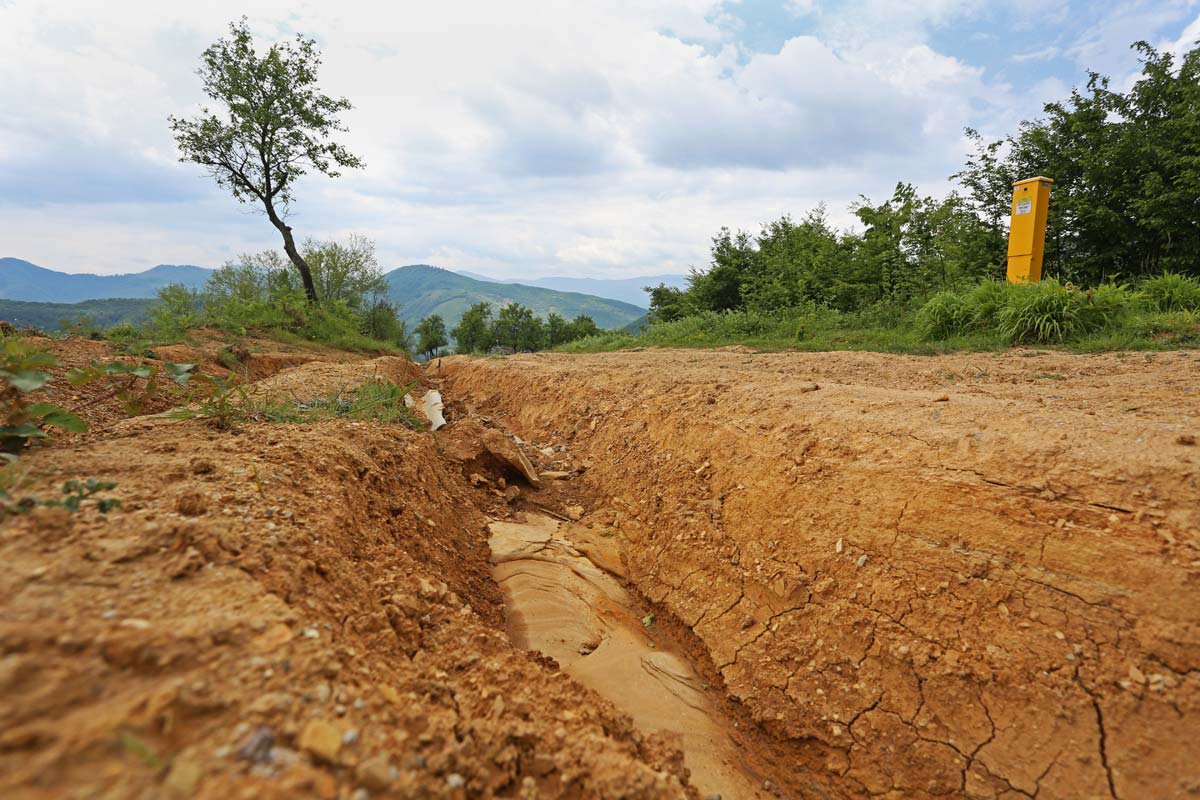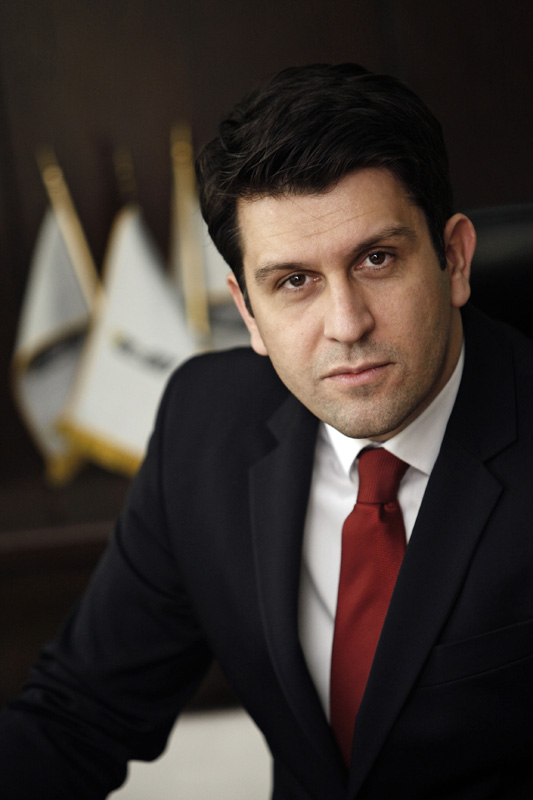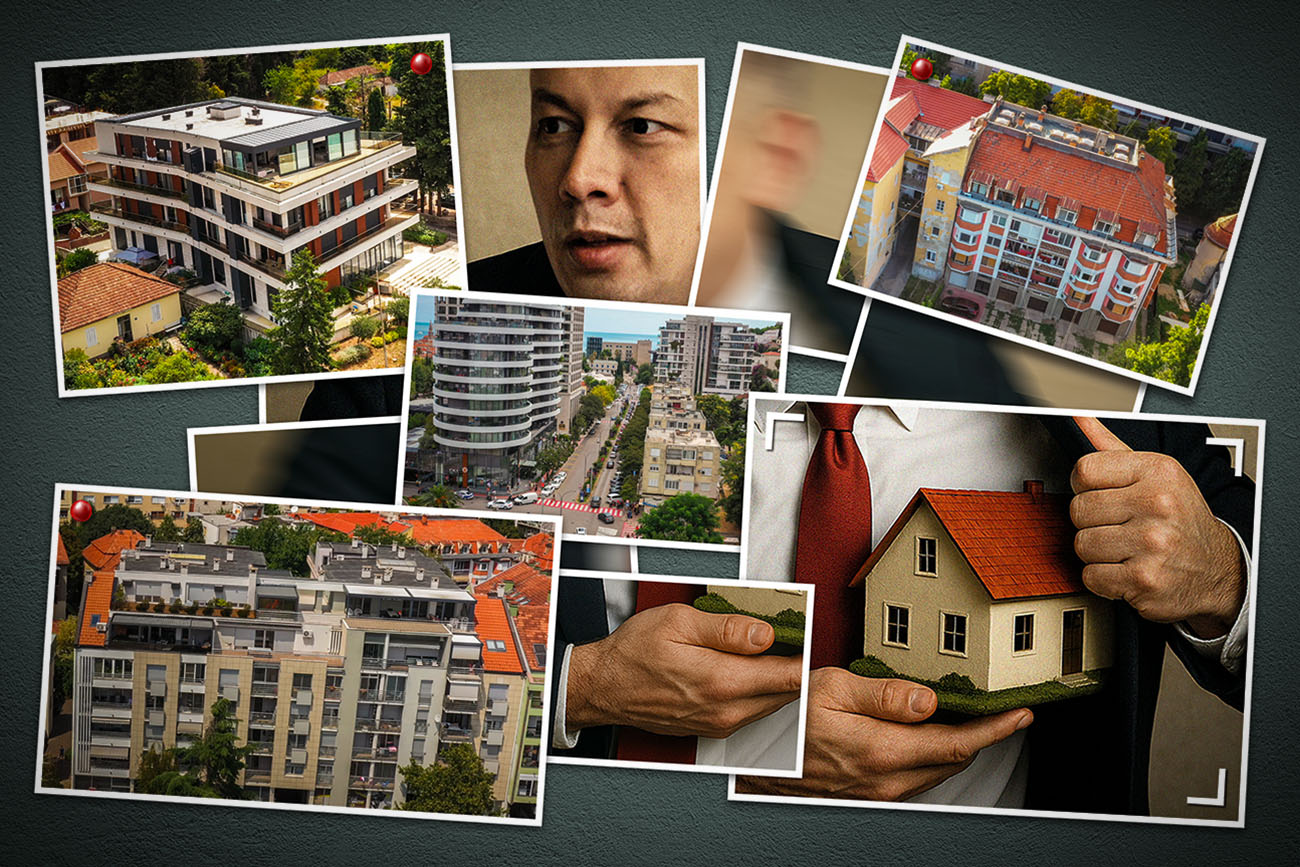When the team from the Centre for Investigative Reporting in Sarajevo (CIN) walked along the Zenica-Travnik pipeline, little pointed to the fact that beneath their feet lay a construction worth 41.5 million KM – around one million KM per a kilometre. Rain has cut deep lines along the slopes of the pipeline’s route. One could see wooden stakes across the slopes pounded into ground at irregular stretches and woven together with branches to contain the erosion. But, the branches were rotting away into the soil which is still slowly sliding down.
Josip Mlakić lives near the pipeline’s route. He fears the possibility of an explosion as he pointed at a yellow pillar, part of a cathodic anticorrosion protection system, which was toppled and has laid on the ground for more than a year. The pillar featured the logo of its owner, the public corporation BH Gas and the telephone number of its maintenance department.
“A year ago I called to notify them, but no one came,” said Mlakić, adding that, since the end of construction, he has never seen anyone checking the pipeline or its above ground facilities.
Don't want to miss our stories?
Sign up for our newsletter.
Don't want to miss our stories?
Sign up for our newsletter.
During the planning and construction of the 40-kilometer long pipeline, the government of the Federation of Bosnia and Herzegovina (FBiH) changed three managements in BH Gas. Because of their bad business moves and mutual animosities, the pipeline worth 41.5 million KM failed to pass tests and receive a certificate of final acceptance and is prohibited from operating. It has been standing useless and potentially dangerous because it’s filled with gas.

During the term of general manager Almir Bečarević, the pipeline was planned and the loan was secured; the corporation bought pipes and selected a contractor and a supervisor. The next management led by Adnan Kreso refused to sign off on the construction contract for three months. The third management team headed by Mirza Sendijarević, which was ushered in after the construction ended, wrote in its review that the job was poorly done and refused to pay the constructors in full. To this day, BH Gas owes them 3.36 million KM.
This is why the Croatian firm, Monter SM, which led the consortium of contractors, filed a lawsuit with the court of arbitration at the BiH Foreign Trade Chamber of Commerce in October 2015. The court has reached no decision yet.
The First Management’s Plan
Unlike its neighbours, BiH is a small customer with underdeveloped infrastructure. It is not energy independent and its sole source of supply comes through a Serbian pipeline via Zvornik before going on to Sarajevo and Zenica. This is why BH Gas planned to stretch the pipeline southward across the Central Bosnia Canton and connect it to the Croatian pipeline system. The project was supposed to bring in new customers and provide stability in gas supply and would enable BiH to strengthen its position when it comes to negotiating the prices of the sale and transport of gas.
Research showed that a new pipeline could supply around 180 million cubic meters of gas to residents, public institutions and companies in Busovača, Vitez, Travnik and Novi Travnik. For comparison’s sake, this amount of gas is the same amount of gas now planned to be delivered to all FBiH customers during 2016.
Along with the main pipeline, a local distribution network was supposed to have been built to entice new customers, but despite many meetings with potential investors, the Cantonal authorities were unable to find a suitable investor. In 2010, no company applied to its only public call for bids.
The then general manager of BH Gas, Almir Bečarević, told CIN that a decision was made to start building the Zenica – Travnik pipeline come what may because it was more important for BiH to connect to the Croatian network and secure a second source of gas than to find new local customers.
“Give me a possibility to trade and find me a cheaper (supplier) … and I have made a profit without a customer,” said Bečarević.
In 2010, he took out a 33.2 million KM loan from European Bank for Reconstruction and Development (EBRD). A consortium was set up between Monter SM from Zagreb, which laid the pipeline, and Sarajevo-based GP Put, which dug the channels and covered them with soil after the pipes were laid. The cost of work was agreed at a price of 23.4 million KM. The inspection upon completion was entrusted to a Zagreb-based Institute IGH and its partner firms Komsel from Zagreb and Elmon Engineering from Sisak. It was agreed that the price of inspection would depend on the number of working hours carried out, without exceeding 427,439 KM. A Turkish company Umran Celik Boru Sanayii A.S. sold the pipes for around 6.7 million KM.
Meanwhile, the Party for BiH, which supported Bečarević lost the elections in FBiH, so a new management team was appointed to BH gas. The new supervisory board that included businessman Goran Žagovec, appointed Adnan Kreso as the BH Gas’s general manager in September 2011. As well as both belonging to BiH Social Democratic Party (SDP), Kreso and Žagovec were also critics of the rationale for the pipeline construction project.
Adnan Kreso’s Reluctance
The new general manager staved off for three months the signing of a contract with the selected consortium. “I knew right away that this was a bad investment and that nothing would come out of it,” Kreso told CIN.
He explained that he doubted the economic sustainability of the pipeline and the projected number of potential customers that was used in the Canton’s 2006 Gasification White Paper. Eventually, he signed the contract. “The government ordered us to proceed,” said Kreso.
Former FBiH Prime Minister Nikšić said that Kreso was verbally opposed to the project, but in a memo to the FBiH government the then general manager wrote that all preparations were completed and that BH Gas intended to sign the agreement.
“Oh my Lord, he demanded that we get out of all this and then he wrote the opposite,” said Nikšić and added that Kreso was not up to the job and was sacked.
The then member of BH Gas’s Supervisor Board Žagovec told CIN: “In the month of February, when it was clear that SDP got (political control of) BH Gas … I tried through some of my people from SDP, who I knew, to intervene to halt the procedures…” However, when the construction began, Žagovec had a change of heart and Monter SM subcontracted his firm GMC Engineering.

Žagovec said that he did not participate in the selection of Montera SM as contractor, because he joined BH Gas after the elections – and therefore, he did nothing illegal.
The FBiH Financial Police disagrees. In its December 2013 report, it suspected Žagovec of abuse of office, benefitting to the amount of at least 37,158.34 KM and filed criminal charges against him with the Sarajevo Canton Prosecutor’s Office.
The financial police also wrote in its criminal report that Žagovec and Monter SM tried to hide their collaboration. In its report, the police quoted Suzana Zeljko, one of Monter SM’s then managers, who wrote to Žagovec that it would be illegal to hire his firm as a subcontractor and explained how they could by-pass the law.
“Machine works on the Novi Travnik stretch we could negotiate fully with you, but we cannot nominate you as a subcontractor. We could make an arrangement with your firm to hire people, machines and other equipment,” wrote Zeljko to Žagovec. “That would remain between us and would not be made public.” Sarajevo Canton prosecutors are looking into this and other charges against the managements of BH Gas.
Construction Issues
At the moment when the construction contract was signed, at the beginning of 2012, BH Gas’s construction license was good for only 11,78 kilometres, or one-quarter of the pipeline’s route.

Adnan Terzić, the general manager of GP Put, recalls how it was rare to have two adjacent parcels of land ready to work on: “One would be free, the other would not”.
During Kreso’s term the management blamed delays in construction on this issue in their report to the FBiH government. The contract was amended twice in order to prolong the end of works for seven months, increasing the costs by more than one million KM.
However, Kreso’s predecessor Bečarević, during whose term the pipeline’s route was laid out, said that there was no evidence that land purchase issues were the cause of delays, that is, no record keeping tools or log books were kept during the construction that recorded this.
The current general manager of BH Gas, Jasmin Salkić, said that the corporation’s commission that spent 45 days writing a report on the pipeline could not establish all the parcels through which the pipeline went.
“I asked them at a meeting: ‘Do we at least know what is the official route of the pipeline?’ They told me that they could not establish it…”
Bečarević said that the culprits were the constructors who, instead of noting down in the log what had been done, wrote what they planned to do.
The project caused disagreements between BH Gas and both its contractors and supervisors. The corporation blamed GP Put for not laying concrete channels to drain surface water. GP Put said that the project’s blueprint did not call for the channels and added that BH Gas owes them another million KM.
The project also did not envisage a third PEHD pipe that could eventually host optical cables and other installations. It’s been laid down, but no one knows who owns it.
Juraj Prinčić, general manager of Elmon Engineering, one of the companies that was involved in the supervision of the construction said that to make an issue out of the fact that there was a third pipe was beside the point.
“It does not matter – you can place two, three, five or fifty. When you insert a cable you can rent it.”
Prinčić said that BH Gas had agreements with BH Telecom and the BiH Power Utility Corporation to lay down more pipes than the blueprint had envisioned. It paid for putting the pipes in place and hired BH Telecom Engineering to oversee them.
However, BH Gas has no paperwork on the third pipe apart from working documents that point to the fact that Kreso orally ordered the third pipe to be put in place, according to the management.
At the end of October 2013, construction works on the pipeline were completed. Now, everything rested with a commission of the FBiH Ministry of Spatial Planning that was supposed to review the paperwork, inspect the pipeline and issue the certificate of final acceptance.
“We have just been short of the finishing touch,” said Prinčić.
However, at that moment, the FBiH government decided to sack Kreso whose bad management led BH Gas to the edge of bankruptcy. In the beginning of December 2013, Sendijarević was appointed new general manger instead of Kreso.
“I arrived at the final act. We wanted to see where we stand and so we set up a team. The Internal Control Department established a number of faults with the pipeline,” he said.
Then, new problems arose.
Conflict with Contractor and Arbitration
The commission set up by BH Gas pointed out in its December 2013 report that they had found gas leakages at 12 points in the pipeline and another 94 faults in the operating, measuring and control systems, as well as power installations and anticorrosive and fire fighting protection.

After the contractors had corrected the faults, the commission went out again and detected new faults in the fences for the above-ground facilities, which were thinner and of less quality than had been agreed to, as well as missing measuring software and accompanying paperwork for one type of vents. Another two years went by in rounds of negotiations and often agitated discussions between BH Gas and the contractors.
Without waiting for the ministry to issue the certificate of final acceptance, BH Gas terminated the contract with the contractor in March 2014. The president of Monter SM’s management Franjo Novosel said that they could have corrected the faults quickly but BH Gas’s management did not let them. They terminated the contract and refused to pay the full sum. Today, BH Gas owes the contractors 3.36 million KM. Sendijarević told CIN about the reasons: a part of the route has not been returned to its original state; some stretches of the pipeline were not dug deep enough as required by the blueprint; on some slopes the water eroded part of the soil covering the pipeline, while along the pipeline a third PEHD pipe was laid, which does not exist in the blueprint.
Two months later, the FBiH Ministry of Spatial Planning issued a directive and gave BH Gas 90 day to correct twenty minor faults. After this, the company sued the ministry and wrote that the directive was incomplete and that it legitimized faults like: soil erosion on slopes; lack of adequate protection from erosion and the issue of the third pipe.
The Ministry’s Igor Dizdar said that they were surprised by the lawsuit because it is rare for an investor to be bothered by the fact that a small number of problems had been detected. “As far as we are concerned, as soon as they had corrected the faults they could have received the operating license. Now this will go on. In our experience, it lasts three to four years.” Even though it refused to take over the pipeline for two years, BH Gas did it in October 2015.
Postscript
In the beginning of August 2016, the new management informed the public that an unknown culprit, most probably an employee of BH Gas, had filled with gas a 4-kilometer long branch of the pipeline in the direction of Novi Travnik. This stretch had been done by Žagovec’s firm and was the only part of the pipeline to be left empty when gas mysteriously leaked in 2014.








